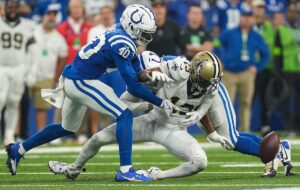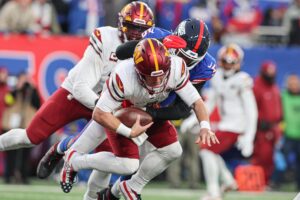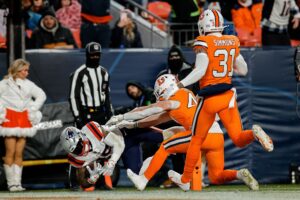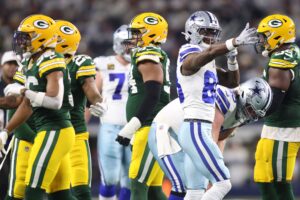In 2015, the New York Jets received the sixth pick in the NFL draft, and watched pro-bowler Leonard Williams fall right into their lap. In the NFL, it is rare such an opportunity presents itself. And thus, in 2016, Mike Maccagnan’s predicament was not so favorable. Recipients of the 20th pick, the Jets had no future Pro Bowler drafted. Nevertheless, here’s how Maccagnan fared in his second draft.
Grading the New York Jets 2016 Rookie Class
First Round: Darron Lee
It’s important to preface these evaluations by stating that each and every grade is subject to change. The Jets were, after all, building a team for the future, not just last season. Nevertheless, much can be learned about this class from just one season. Firstly, linebacker Darron Lee flashed some potential, but at points struggled mightily during his first season. Early in the season, Lee struggled in coverage and was often overzealous in chasing the ball carrier. Lee improved later in the season, receiving more playing time in place of David Harris. Lee undeniably experienced some growing pains in his first season. But overall, if he stays the course, I believe the Ohio State product will develop into a productive starter for the Jets.
Grade: B-
Second Round: Christian Hackenberg
Christian Hackenberg is a project. Mike Maccagnan knew that when he drafted the Penn State signal caller, and he knows it now more than ever. The question is, just how large a project did the Jets undertake? Hackenberg led one good drive in the Jets third preseason game, and suffered a miserable game in week four of preseason. And that’s all the experience Hackenberg got. Following Hackenberg’s season that wasn’t, reports have come out bashing the quarterback. Apparently, he “couldn’t hit the ocean”, will never develop into a staring quarterback, and is downright terrible, according to various Jets team sources. Not exactly high praise. While such rhetoric is perhaps unfair, it is troubling nonetheless. There’s a long time between now and next season, and this off-season will be critical to Hackenberg’s development. For now, though, the quarterback remains an enigma.
Grade: Incomplete
Third Round: Jordan Jenkins
The Jets need edge-rushers, so selecting Georgia lineman Jordan Jenkins was a smart decision. Jenkins preformed, more than anything else, like a third-round pick. He was a fairly low-impact player, recording over 2.5 sacks. Although he saw more playing time later in the season, the results remained consistent. Overall, he wasn’t egregious, nor was he outstanding. There’s a chance Jenkins develops into a productive starter, but he will likely remain a serviceable rotation player. Not a great pick, but not a poor one, either.
Grade: C
Fourth Round: Juston Burris
The Jets early-round picks failed to impress greatly in their respective first years. However, Maccagnan may have saved this class with a plethora of shrewd late-round selections. Juston Burris, a fourth round selection, impressed in his first year with New York. Burris began the year as the fourth cornerback, and received minimal playing time accordingly. However, the NC State product became a starter late in the year as the Jets turned to their youth to salvage a lost season. Burris played well, defending four passes and intercepting one in a three week stretch. Burris isn’t the next Darrelle Revis, but he played admirably for a fourth round selection, and should be a day one starter in 2017.
Grade: B+
Fifth Round: Brandon Shell
Breno Giacomini will likely not return, bearing a large contract and an inexplicable tendency for boneheaded penalties. Luckily for the Jets, the team selected Brandon Shell in the fifth round. Shell, like Burris, received virtually no playing time until very late in the season. Upon starting, Shell impressed, not allowing a pressure until his third start. What’s most impressive is Shell’s improvement throughout the season. Starting in the final game of the preseason, Shell struggled mightily against backups. Just four months later, he was preforming well against starters. Shell should be the Jets 2017 right tackle, and has the potential to be quite a good one.
Grade: A
Sixth Round: Lachlan Edwards
Acquiring a young punter was a smart decision, particularly in the late rounds of the NFL draft. Only problem being, Lachlan Edwards failed to produce as a rookie. The Australian punter was touted as having a big leg, but was in actuality woefully inconsistent. Edwards finished the season dead last in the league in net average and 28th in yards per kick. Edwards suffered an egregious blunder to boot, gifting the Baltimore Ravens seven points after a mishandled snap. The Jets shouldn’t give up on Edwards, but they would be wise to bring in some veteran competition in 2017.
Grade: D-
Seventh Round: Charon Peake
Clemson produces NFL ready wide receivers at a simply uncanny rate. Following the departures of Sammy Watkins and Deandre Hopkins, Charon Peake joined the Jets in 2016. While Peake is nowhere near as talented as the aforementioned two wideouts, he had a nice first season with the Jets. Keep in mind, this is a seventh round pick. The majority of picks this late are either cut, end up on the practice squad or struggle to make an impact. Peake tallied 19 catches for nearly 200 yards, flashing some potential late in the year. On a team crowded with young receivers, Peake showed he might be an impact player for the Jets down the line. With the 241st overall selection, you can’t expect much more than that.
Grade: B+
Undrafted Free Agents
Of the 13 free agents signed by the Jets, three are of impact: Robby Anderson, Jalin Marshall, and Doug Middleton.
Firstly, Robby Anderson shined in his rookie year. The Temple wideout displayed some serious potential, especially when Bryce Petty was throwing him the ball. The tall, wiry receiver was an absolute burner, affecting defenses with his speed and height. Anderson is still raw in some key areas, but he was a bright spot in the Jets dismal offense.
The assessment of Jalin Marshall is more complicated. While the receiver made an major impact, it was not always a positive one. Tasked with the Jets primary return man, Marshall struggled mightily. More often than not, he either ran backwards or took an unnecessary beating instead of calling a fair catch. On the other hand, Marshall showed some talent as a receiver, and showed more than most expected. The challenge for Marshall will be standing out amongst an array of young receivers.
Lastly, Doug Middleton was primarily a special teams player, although he received snaps at safety at the end of the year. Middleton preformed well on special teams. He’ll never be a star, or even a starting safety, but teams need guys like Middleton to anchor special teams. This was a solid pickup
Grade: A
Overall
Mike Maccagnan, in all likelihood, found himself a few quality starters. That being said, the concern with this class is that its ceiling is low. In 2015, Maccagnan’s draft was weaker across the board. Yet in that draft, the Jets acquired Leonard Williams, a franchise cornerstone and pro-bowler. Of the 2016 bunch, there’s simply no player of that potential. If Hackenberg develops into a quality starter, this class will be looked upon very favorably. If not, Maccagnan gained his team an array of quality players, but little else. Solid, yet unspectacular, was Maccagnan’s second draft.
Overall Grade: B-






